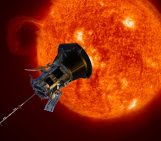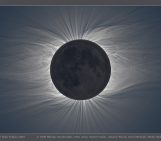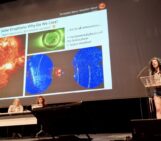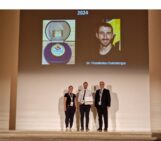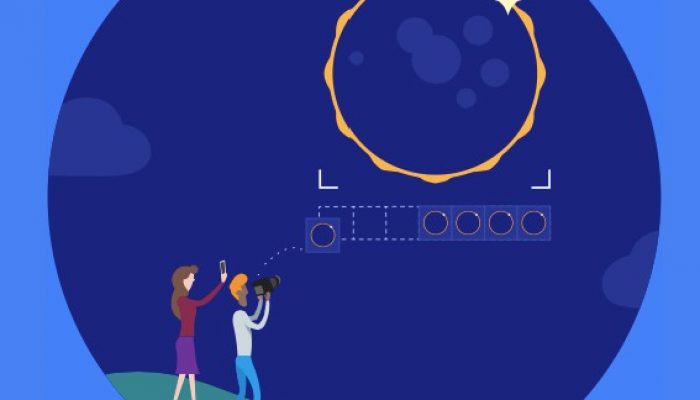
by Hugh S Hudson (U. of Glasgow and UC Berkeley)
Normally solar eclipses give an observer only a fleeting moment (minutes at most) to enjoy the solar corona. We aim to amplify that considerably in the August 21 eclipse across North America. The plan is simple: Megamovie will capture everybody’s images, especially those from a group of 1,000 photographc volunteers, and compile them into an open-source archive that (weather permitting) will span an hour and a half of the corona’s life. One can find this program at the URL “eclipsemega.movie“, and in the smartphone app “Eclipse Megamovie Mobile“.
The path of totality crosses the entire continent of North America, well-populated with eager observers equipped with the latest things in consumer electronics – marvelous cameras plus GPS and the Internet. The previous occurrence, in 1918, had none of that. The program is thus a citizen-science project, embracing all levels of experience and capability among the observers, and at the same time it will produce a systematic record that we believe will be the first of its kind, and certainly can be the largest. We intend to follow up with citizen-science analysis projects, along the lines of SETI@Home and Zooniverse, to make sense of the very complicated records.
Megamovie does new and original things that will create real science. For the corona, the existence of the archive itself is unique. Here we will have vast oversampling in the time domain, with access to disturbance modes on short time scales seldom observed with such resolution. Here we expect to see waves and flows in the low corona, by following the intensity variations of discrete features. Of course the Megamovie archive can extend to time scales of tens of minutes, where we know that large-scale structures will show perceptible and dynamically interesting motions. How much does a streamer wobble, and in what mode?
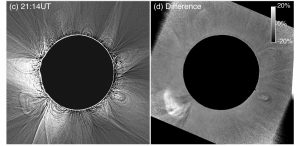
A CME and other structures captured in eclipse observations by Hanaoka et al. (2013); the left panel is an edge-enhanced view of one stacked image at 12-Nov-2012 20:39 UT. The right panel is a difference against observations from a different site at 21:14 (this is a cropped version of Figure 1 of the manuscript used by permission from Dr Y. Hanaoka)
The uniqueness of the August 21 eclipse continues with the coincidental presence of the bright star Regulus. This reference point will show up in all of the deep coronal images. In addition we have recently achieved precise astrometric information about the Moon, derived from the Kaguya and Lunar Reconaissance Orbiter missions; this eclipse will be the first major opportunity to apply this new information to eclipse data and the Sun.
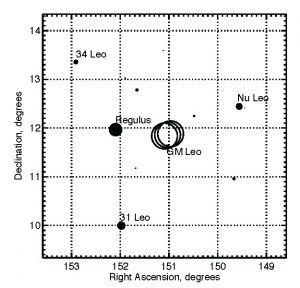
The star field at the time of the August 21, 2017 eclipse,showing the position of the Sun as it moves during totality, and also the nearby bright star Regulus. (Figure provided by H. Hudson)
These advantages should make it possible to analyze and correct many images at a precision rivaling that of the famous Eddington observations in 1919. We note that this historically important confirmation of general relativity has been repeated with modern detectors such as those found in everyday consumer electronics now. The Megamovie Mobile app (free) provides many resources for smartphone users; the mere timing of Baily’s Beads will make a systematic recording of the shadow path and thereby the local instantaneous radius of the Sun. The app does this automatically, and even without a cheap telephoto attachment, a smartphone camera can get wonderful timing information with precise GPS metadata.

